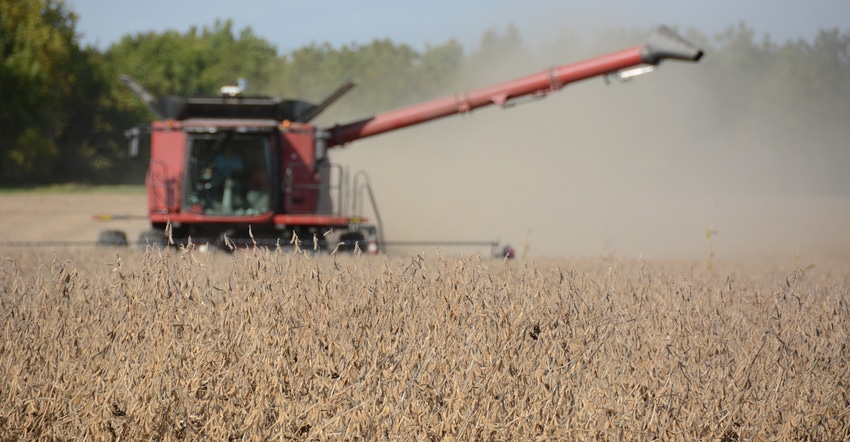
When the much-awaited U.S. EPA verdict came in last week extending the dicamba label for in-season use on soybeans through 2020, it answered big questions about the future of the product — but it left many details still murky.
“Overall, I think it further addresses some key areas of concern to improve the performance of the system,” says Regan Wear, CHS agronomy manager at Shipman, Ill., and chairman of the Illinois Fertilizer and Chemical Association. “For the most part, these changes are workable and will help us keep this important technology for improved weed control.”
Wear adds that the new restrictions limiting application on soybeans to 45 days after planting, or prior to R1 growth stage, allows farmers and applicators to make plans for in-season applications and for the residual products they’ll need to control weeds.
He believes additional parameters restricting applications from one hour after sunrise to two hours before sunset will help manage hard-to-predict temperature inversions.
Testing?
EPA also declared that all applicators need to be certified to apply the product, and those working under the supervision of a certified applicator are no longer allowed to make applications. As of press time, the actual label had not been released and retailers were continuing to seek clarification.
“There is a lot of confusion and concern in Illinois as to whether thousands of licensed operators who work in retail will have to now take the applicator exam, which is an additional exam,” says Jean Payne, IFCA.
The Illinois Department of Agriculture has confirmed to Payne that under the new label, a farmer who is a private applicator can also use and supervise a pesticide application on their farm. However, if they want an employee to spray dicamba, that employee must also have passed the private applicator exam, which is a combination of the general standards and field crop exams.
According to Payne, Illinois has 5,000 licensed commercial operators, who perform the majority of all commercial applications.
States are unique in how they license applicators and operators. In Illinois, the pesticide act outlines the following categories of testing and licensing:
• Certified applicators. This includes commercial applicators and private applicators.
• Licensed operators. These folks have to take the general standards exam to be a licensed operator, which allows them to work under the supervision of a licensed commercial applicator.
“We have asked the Illinois Department of Agriculture to help determine how these definitions impact Illinois applicators,” she says, adding that operators may need to take the additional field crops exam to become certified. But for now, she says they’re advising their members to sit tight and wait until the product labels are issued.
“Resolving this uncertainty is IFCA's top priority, and we believe that the fact that our licensed operators have demonstrated competency meets the intent of what appears to be the desire by the registrants and U.S. EPA to have only trained, certified and licensed persons apply these products,” Payne adds.
She says if additional testing is required, they’ll work with IDOA to train applicators. And, she says, in that circumstance, they’ll push to make sure the dicamba-certification process doesn’t include the full payment of a three-year applicator license.
Buffers
EPA also said that in counties where endangered species may exist, the downwind buffer remains 110 feet, and there is now a new 57-foot buffer around the other sides of the field. The 110-foot downwind buffer applies to all applications, not just in counties where endangered species may exist.
Payne says that will impact every county in Illinois, as all 102 counties have an endangered species of some kind. “Therefore, the 57-foot buffer on all sides, along with the 110-foot downwind buffer may also apply statewide. We will need to see the labels to better understand this and other requirements,” she adds.
In terms of pesticide management, agronomist Karen Corrigan, McGillicuddy Corrigan Agronomics, doesn’t see much difference in this new label relative to last year.
“The restriction on 45 days after planting is interesting in a state where we have early-planted beans, late-planted beans and double-crop beans. It basically says there is a limit, but in reality, there isn't,” she says. “Double-crop beans planted the first week of July can be sprayed until mid-August. An actual date would have been more helpful.”
Corrigan remains concerned about susceptible crops, particularly in areas where non-GMO contracts are prevalent. She says the new label doesn’t address the impact the product had on specialty crops, trees, individual property, and wildlife and recreation areas.
“Farmers’ choice is limited by their neighbor's choice in both directions,” she says. “We have already seen some resistance issues. If people believe this is their only choice, then resistance will become the limiting factor for the product sooner rather than later.”
EPA’s dicamba restrictions for 2019-20
EPA’s restrictions include:
• Only certified applicators may apply dicamba over the top; those working under the supervision of a certified applicator may no longer make applications.
• Over-the-top application of dicamba is prohibited on soybeans 45 days after planting, and on cotton the prohibition starts 60 days after planting.
• Applications will only be allowed from one hour after sunrise to two hours before sunset.
• For cotton, in-season over-the-top use of dicamba is now limited to two applications, down from four; for soybeans the restriction remains at two applications.
• In counties where endangered species may exist, the downwind buffer remains 110 feet, and there is now a new 57-foot buffer around the other sides of the field. The 110-foot downwind buffer applies to all applications, not just in counties where endangered species may exist.
• The training period for 2019 and beyond will be clarified to ensure consistency across all three approved products.
• Enhanced tank cleanout instructions will be issued for the entire system.
• An enhanced label will be created to improve applicator awareness on the impact of low pH on potential volatility of dicamba.
• Labels will be cleaned up for greater consistency to improve compliance and enforceability.
About the Author(s)
You May Also Like






